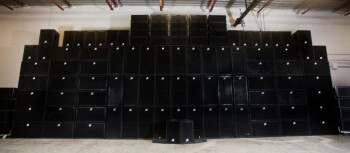The notion of power is always highlighted by manufacturers and users alike. It seems to have a sort of exceptional seduction power, to the point that its actual importance gets diluted in the mental image that the general public has of it. So it's only wise to be cautious in this regard, especially considering that test conditions among manufacturers are far from being identical.
Theory and practice
Power handling can be described as the amount of electric current delivered by the amp that a speaker can handle. It is often misunderstood and is still commonly used to compare the quality of two speakers. However, it doesn’t tell you everything about the SPL delivered and, hence, the efficiency of a speaker. It indicates the maximum signal voltage you can send to a speaker before it is subjected to noticeable changes in its acoustic, mechanical or electrical characteristics. At best, the power rating stated in a speaker’s spec sheet serves to determine the power of the amp to be utilized, depending on the type of use. Problem is there are different ways to calculate power handling. The most serious manufacturers usually distinguish themselves by providing a detailed explanation of the measuring conditions.
The equation to calculate the amount of power P (in watts) that a speaker receives is P = V2/Z, where V is the signal’s voltage, in volts, and Z the impedance, in ohms. A test signal at different gains is used to determine the number of watts that a speaker can handle. The voltage at the binding posts is measured and, since the impedance is known, it’s easy to calculate the power. The response of the speaker is monitored and the handling power is determined depending on the alteration of the frequency response, the distortion rate, and any eventual overheating and excessive displacement of the voice coil.
The Audio Engineering Society (AES) recommends a two-hour test. But there are other protocols in place (like that of the Electronic Industries Alliance or the International Electrotechnical Commission…). And it’s not that unlikely for manufacturers to define their own tests, modifying the test signal, the duration of the test or the way the signal is played back (continuous or not). In order for the user to make any sense of the rating, he must know the protocol used. The lack of documentation regarding the power rating is pretty suspicious.
Mean and peak power
Given the constant variation of signal amplitude, to make the test reliable, you need to distinguish between Root Mean Square (RMS) level ─ corresponding to a mean value different from the simple mean ─ and Peak level ─ corresponding to the signal’s peak voltage, i.e. very short instants during which the voice coil displaces the farthest within the magnetic field (typically due to the attack of certain sounds). It’s easy to understand what peak level is, but RMS is often confused with the simple mean, even though they are mathematically different. RMS voltage values, in volts, are used to calculate the average power (not RMS), in watts. If you had two samples, one with a value of 0, the other one with +10, their mean value is (0 + 10) / 2 = 5, while their effective value (RMS) is √(02 + 102) / 2 = √50 = 7.071. “RMS” is just an abbreviation and doesn’t have a physical reality.
Crest factor
Given the utility of knowing the power handling during an extended period of time and brief peaks (some milliseconds), the gap between RMS and peak values of the signal test must be calibrated. The ratio between them is called Crest Factor. In 2012 the AES updated its “Methods of measuring and specifying the performance of loudspeakers for professional applications, ” superseding the old standard dating from 1984. In this new version they recommend the test signal to be pink noise with a crest factor of 12dB, in other words, a ratio of 4:1 between the RMS and peak voltage delivered by the amp, and 16:1 between the mean and peak power that the speaker can handle. The crest factor was only 6dB in 1984, while the ratio between RMS and peak voltage was only 2:1 and 4:1 between mean and peak power. Power varies proportionally to the square of the voltage (P = V2 / Z).
On some spec sheets you can also find a “program power” rating, which corresponds to the mean power multiplied a number of times (determined by the manufacturer). It specifies the amplification power the manufacturer considers adequate for the speaker (most commonly twice the average power). Something similar applies to the so-called “Music Power, ” where the manufacturer determines the recommended power for the speaker when used with music. But…what kind of music? Uncompressed jazz or EDM with almost no differences between the softest and loudest parts? Good luck finding out…The crest factor of the test signal is indispensable to correctly interpret the power value written in the specs. Thanks to a signal normalized this way, you can deduce the peak level from the mean, and vice versa. With this info and the specs of the amp, you can determine the correct power amplification needs of the speaker, depending on the use.


